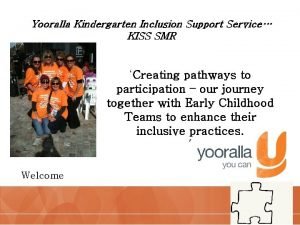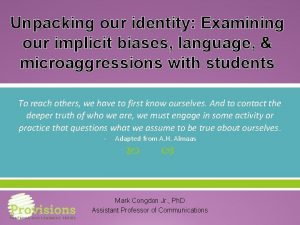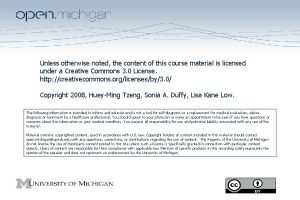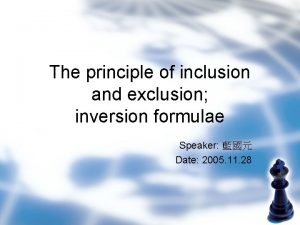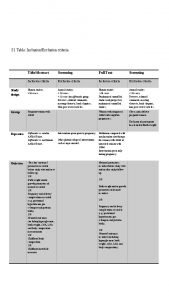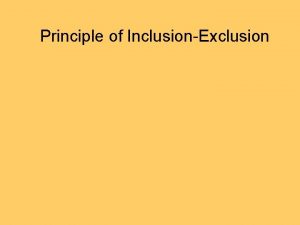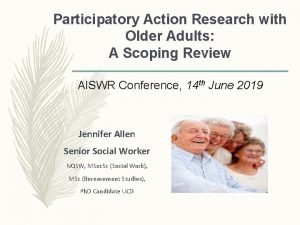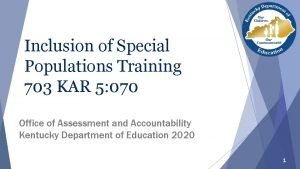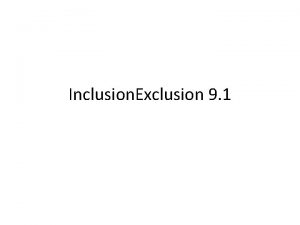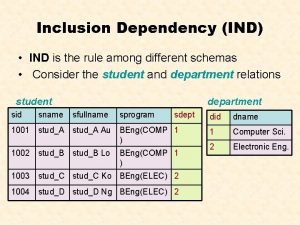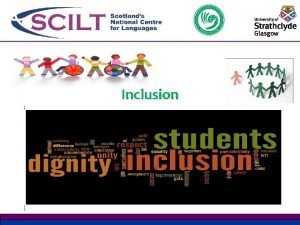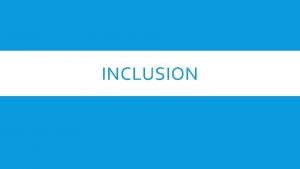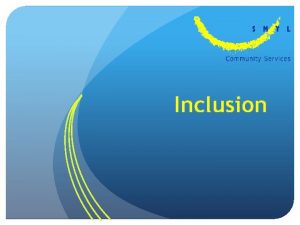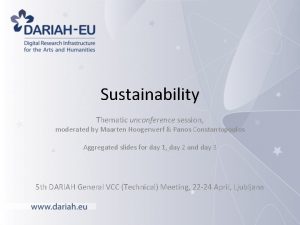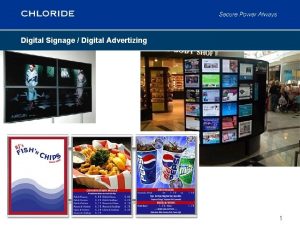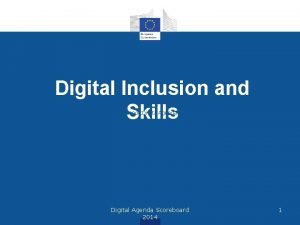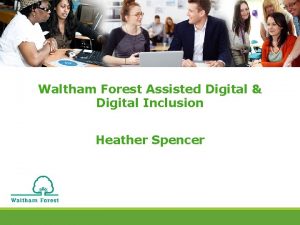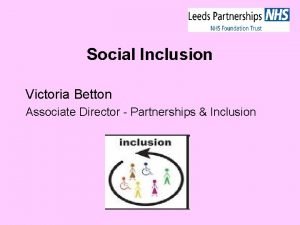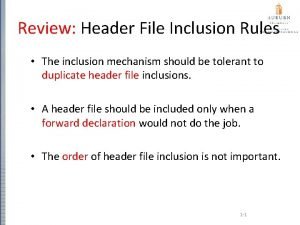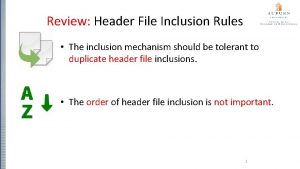Towards full digital inclusion EvertJan Hoogerwerf EvertJan Hoogerwerf




















- Slides: 20

Towards full digital inclusion Evert-Jan Hoogerwerf

Evert-Jan Hoogerwerf Affiliations Head of Sector Projects &Innovation AIAS BOLOGNA Onlus Emilia Romagna’s Regional Centre for Assistive Technology Independent Assistive Tecnology Centre in Bologna, Italy www. ausilioteca. org Mail: hoogerwerf@ausilioteca. org Past President and project manager ASSOCIATION FOR THE ADVANCEMENT OF ASSISTIVE TECHNOLOGY IN EUROPE Sector organisation Members in 24 countries. Office: Linz Austria www. aaate. net Mail: hoogerwerf@aaate. net


Digital inclusion Bridging the digital divide Access to employment and education More fulfilled lives More freedom and choice Wider participation in society Access to rights

Full implementation of the UNCRPD The UN 2030 Agenda for Sustainable Development WHO, ITU, UNESCO reports highlighting the enabling role of technology Looking forward Policy drivers European Union legislation and policy programmes

Internet use Households in Europe with access to the Internet use and non-use by disability status, 2014 to 2016, UK 2015: 83% 2006: 50% Source: Eurostat. Digital economy and society statistics households and individuals. http: //ec. europa. eu/eurostat Source: Office for National Statistics (UK)

www. entelis. net Reducing the digital divide together Supporting the development of digital skills of persons with disabilities of all ages Policies, strategies and tools Study into Opportunities and Barriers to full digital inclusion • • Literature review Assessment project outcomes Direct investigation involving stakeholders (surveys, interviews) Living labs

Barriers to full digital inclusion - Society Level Area of interest Barriers Societal Politics and policy ● ● ● ● Culture ● ● ● Lack of an inclusive mainstream approach at all policy levels and in many policy fields. Lack of collaboration and coordination among public institutions. Lack of innovative approaches encouraging independence (e. g. commissioning structures that pay based on what is ‘wrong’ with people and not on personal objectives). Insufficient or inadequate legislation (e. g. web/media accessibility). Failure of existing legislation to effectively cover essential aspects of ICT/ICT-AT for Pw. D. Lack of policy to systematically address the digital divide with adequate resources. Lack of priority given to ICT-AT education in the national disability and rehabilitation agenda. Society, including media, often reproduces a stereotyped view of disability. Prevalence in social and educational settings in many countries of the deficit model of disability, discouraging ICT-AT effective use. Terminology incompatibilities and discrepancy in awareness and proficiency levels in relation to ICT/ICTAT policy and practice. Usability and accessibility ● ● Inaccessibility of mainstream technology. Complex and challenging interfaces and user experience. Lack of awareness and understanding of Pw. D’s needs among product designers and developers. Lack of interoperability between technologies. Financial, economic ● ● The unavailability of specific devices on national markets. The cost of the technology for the end user and/or for the provider, especially where public funding is not sufficient. Limitations in the provision of additional resources (e. g. training, add-ons, etc. ) Lack of facilitating resources (e. g. equipped computer labs). ● ●

Barriers to full digital inclusion - Community Level Area of interest Barriers Community Competence/ guidance/ education ● ● ● ● Services and support ● ● ● ● ● Lack of general awareness on the opportunities offered by technology for activities and participation of people with disabilities. Ineffective information management and organisation of the information among information holders and authorities. Lack of competence in helping people assessing their needs and matching the needs with the available solutions. Lack of user-centred and user-driven approaches. Lack of ICT & ICT-AT competencies and confidence to use technology among professionals, including teachers and educators. Uncertainty about how to use it and to train others in using it. Lack of sufficient user training and appropriate personal support. Educational systems are not fully prepared to support learners with disabilities in developing their ICT and ICT-AT skills. Lack of independent advice and knowledge centres. Lack of AT specialists in rehabilitation teams. Lack of interagency collaboration. Lack of openness to innovation among service providers. Lack of teamwork among professionals and with the user and his or her informal carers. Poor timing of interventions (e. g. too late, too early, too slow). Insufficient administration with difficulties in procuring and managing equipment and services Inconsistency in the follow-up of technology acquisition. Lack of support over time.

Barriers to full digital inclusion - Person Level Area of interest Barriers Personal motivation ● ● ● Low self confidence. Technology perceived as not useful and not responding to actual needs. Alternative strategies to avoid use of technology. No time in daily routine. Fear that technology use might reduce human care or contact. Security benefits and challenges ● ● ● Risks related to safe internet use. Risks related to personal data treatment. Fear of losing control over technology. Health condition ● Objective activity limitations (e. g. dementia).

High level objectives

A very simple roadmap

Digital inclusion roadmap

Education Roadmap Objectives-Needs-Recommendations Phase Assessment Development & Innovation Objectives Assessment of the whole educational environment and identification of areas of improvement. Needs Standards for the assessment of the performance of education providers in the area of ICT and ICT-AT support to learners with disabilities. Goal setting. Time and resources to perform an objective and complete assessment. Development and delivery of training for staff and management as well as for end users. Vision based decisions regarding reachable goals and priorities. ICT-AT initial education of teachers and other school staff, as well as lifelong learning opportunities and obligations. Qualified staff to support learners with disabilities in developing digital skills. Curricula and competence frameworks to direct learning. Assessment strategies of the learned. Development of a truly person centred approach enhancing skills, participation and independence. Learning opportunities in AT for family members and informal carers. Individualised learning plans and pathways including appropriate assessment strategies and tools and adequate use of digital technologies for learning and personal AT equipment, if needed. Educational strategies and implementation plans for increasing the use of AT in and outside the classroom. Opportunities for the independent assessment of AT needs of the single students and regular reviews. Recommendations Standards and assessment tools should take the whole school environment into account, including the declared mission, the educational culture and the relationships established with other stakeholders in education, such as families, further education, transition to employment etc. Standards and performance indicators Trainers, teachers and educators at all levels and in all types and levels of education should have sufficient competencies and skills to support learners with disabilities in making the best possible use of ICT and ICTAT for learning and for their effective functioning and participation in the digital society. Generally speaking more opportunities for ICT-AT training should be created and offered, respectful of learning needs and preferences of each learner and taking into account the specificity of the individual (e. g. age, condition, etc. ). LLL professional development Schools should fully embrace an inclusive approach based on the recognition of the needs of each single learner. Schools should transfer (digital) skills to ensure people with disabilities can meaningfully participate in all realms of life. Therefore tailor-made support should be provided to enable all people with disabilities to ensure learning and participation. Ensuring self-empowerment is the key to create opportunities for full inclusion. Individualised learning plans Schools serving different age groups should collaborate in the transition of students with disabilities from one institute to another or out of education into employment and collaborate with the families in providing continuity in the digital skills development of the student, including in the selection and use of appropriate assistive technologies that can be used in all life environments, including meaningful employment. Consolidation Implementation and management of change where needed, including communication and attitude change. Action plans to implement change, with adequate timing, resources and monitoring strategies. Ongoing monitoring and regular assessment of individual and sector outcomes (e. g. competences, transitions). Performance indicators for single schools as well as for the entire sector. ICT-AT competence assessment and certification programmes for learners with disabilities. Supporting experts in education (e. g. speech and language therapists, psychologists, pedagogists, etc. ) should be included in the assessment of needs and consulted when needed. Where schools do not have the resources internally, external support should be sought in the form of specialised professionals in AT and multidisciplinary teams for the selection and implementation of AT as well as for educating and training staff. Change management Educational authorities and school directions should regularly monitor outcomes and adjust policies and practices where needed. To motivate learners, to consolidate learning outcomes and to make ICT-AT competences visible, standardised certification schemes and tools should be developed and implemented. Competence frameworks & certifications

Social sector Roadmap Objectives-Needs-Recommendations Phase Assessment Objectives Assessment with clients of ICT opportunities. Needs Assessment strategies to match the person with the technology. Recommendations Assessments should be part of a wider person centred approach, establishing goals related to independence and pathways to reach those goals (including the role of support actors and assistive technology). Assistive technology assessments should start as early as possible and should be repeated as necessary. Assessment whole service environment. Standards for the assessment of the whole service environment. Goal setting. Time and resources to perform an objective and complete assessment, including cost benefit analysis related to the use or non-use of technology to empower service uses. Vision based decisions regarding reachable goals and priorities, taking into account different scenarios and available financial resources. Development & Innovation The social care sector should assess its functioning and level of digitalisation compared to other sectors of the economy and where there are no impediments, adopt technological solutions for reaching the same or higher goals in terms of efficiency, but also quality of life of the assisted. Standards should take the whole social care environment into account, including the declared mission, the goals of care, the culture of care and the relationships established with other stakeholders, such as families, employment services, adult education, etc. Assessments of these standards should take into account the Where needed ensuring additional resources for long available economic resources. term sector innovation. Development and delivery of training for Digital skills as part of the initial education of workers Care workers should have basic ICT skills and be aware of the staff and management as well as end users. in the care sector, as well as lifelong learning importance of ICT and ICT-AT for the people they support. opportunities and obligations. Qualified staff to support clients with disabilities in using personal ICT equipment and in developing digital skills. Development of a truly person centred approach enhancing skills, participation and independence. Opportunities for family members and carers to get familiar with the use of AT. Individualised plans and pathways aiming at empowerment, independence, independent living and de-institutionalisation. Development of models of specialised ICT and ICT-AT service delivery to end users and other stakeholders (e. g. independent assistive technology centres). Implementation and management of change where needed, including communication and attitude change. Action plans to implement change, with adequate timing, resources and monitoring strategies. In each service there should be staff able to support clients in their ICT-AT use. Assessment strategies - individual - environment Goal setting - vision - sector innovation LLL professional development The important role of family members and care workers in the effective use of ICT-AT and in the prevention of its abandonment should not be overlooked. The social care sector should find the right balance between human care and technology supported care, aiming at different but non incompatible goals: quality jobs, humanised care, personalised care solutions, care on demand. Persons with disabilities and older service users should be involved in designing and evaluating user-centered AT services. Developments in ICT towards ubiquity, personalisation, singularisation and digitisation will impact on the type and the way services are designed, delivered and evaluated. These opportunities will have to be embedded into service infrastructures. Services will be different and need new skills, new partnership and management structures, in particular when reaching out beyond traditional organisations into mainstream. Individualised pathways - deinstitutionalisation Change management Where social care providers do not have the resources internally, external support should be sought in the form of specialised professionals in ICT and ICT-AT and multidisciplinary teams for the selection and implementation of AT as well as for educating and training of staff. Consolidation Ongoing monitoring of results in terms of quality of life, cost-benefits and service efficiency. Performance indicators for the sector as well as for single care providers. Only by demonstrating outcomes the social care sector will be able to become a driver of the digital economy. Tools for outcome measurement in terms of costbenefit analysis, client and staff satisfaction, quality of life. Organisations in the social care sector should become role models of ICT and ICT-AT driven inclusion reaching out into all domains of society. Performance indicators - outcome measurement

Technology Roadmap Objectives-Needs-Recommendations Phase Objectives Needs Recommendations Assessment of barriers and reporting of inaccessibility where it occurs at all levels and in all places (including media). Multilingual tools and information channels for the reporting of inaccessible digital environments, products and services. Both guidelines for web accessibility and monitoring tools are available and in some countries they are used on a permanent basis to assess web accessibility (e. g. the Netherlands). Other countries should follow. Developme nt & Innovation Dialogue with industry to impact on the design of new technologies, making these as accessible as possible. Promotion of universal Information and awareness and user centred regarding universal design and of accessibility issues towards accessible mainstream industry and the trainers of products and services. designers and developers. Promotion of the Feeding the innovation cycle development, testing with good and bad user and diffusion of experiences and with innovative information on missing technological solutions, products and services. Political support to research and development programs in this field. Designers of products and services should systematically take human/user-centred design guidelines into account. Different guidelines are available and easy to find on the Internet. Individual needs should be recorded and used to define requirements that can impact on the accessibility and usability of future ICT systems with or without AT. More attention to the whole user experience is needed in the design and development stage of products and services. Consolidati on Supporting the market uptake of innovative inclusive digital solutions for activity and participation of all. Awareness raising regarding interoperability issues among developers of hard and software solutions. Increased efforts to disseminate knowledge about existing solutions and the conditions for successful use. The creation of independent knowledge hubs to support people with disabilities to choose the most appropriate solutions for their needs and wishes. Dialogue with industry Unsolved issues regarding the accessibility of digital environments should be solved by creative innovation driven communities of users and developers. Human-Machine Interaction (HMI) should be intuitive and interfaces should adapt to the person’s needs and preferences. Promotion of interoperability standards. Reporting tools inaccessible digital environments Interoperability standards exist and should be taken into account in all cases. Awareness raising towards designers Feeding the innovation cycle with needs Awareness raising re interoperability issues Independent knowledge hubs and AT centres

Policy Roadmap Objectives-Needs-Recommendations Phase Objectives Needs Recommendations Assessment of gaps and barriers in legal and policy frameworks. Regular monitoring of the implementation of the UN Convention, in particular the articles related to universal design, accessibility and assistive technology. Governments have a key role in driving the inclusive digital agenda. Without high level support for digital inclusion and adequate policy frameworks, a lot of efforts will result in little effect. Collection of good practice and data. Collection of data on participation of people with disabilities in different sectors of public life and of the economy. Assessment strategies will have to be defined that take into account differences between countries and regions, both in level of inclusiveness of policies and services, as well as in technological development of mainstream society. Reporting. Regular monitoring of UNCRPD implementation Collection of outcome studies - evidence Assessment strategies to trace the type of barriers to inclusion in different sectors and the potential role of (assistive) enabling technology to enhance inclusion. The systematic collection of outcomes and outcome studies related to policies in a certain area. Constant monitoring of the alignment of policies and laws with the UN Convention and with the digital inclusion agenda. Development & Innovation Development of policies, sector level strategies, implementation plans, monitoring tools Awareness raising among policy makers. Legitimisation of ICT-AT training in education and supported employment settings. Alliances with other stakeholder organisations at European, national, regional and local level. Structural collaboration with disabled people’s organisations. Consolidation Ongoing alignment of policies with changing global social, technological and educational scenarios. People with disabilities should be actively involved in all decisions regarding them. A core aim of technology adoption should be independence and allowing people to have choice. A comprehensive strategy to bridge the digital divide is needed for all countries and for all administrative levels, taking into account and combatting the different barriers, and investing in the empowerment of people. The strategies should involve organisations with a different focus: policy, education, welfare, employment, technology, research, digital economy, advocacy. Supportive governments, at all levels, particular national government and at a regional level, to help mainstream ICT-AT aided participation of people with disabilities in all realms of life and to develop appropriate strategies, implementation plans and monitoring tools. Governing bodies (e. g. Ministries of Education, Ministries of Telecommunication, etc. ) and local administrators should take the lead and coordinate appropriate action plans, allowing different actors to integrate their contributions to the strategies. Advocacy for more appropriate funding schemes for Assistive Technology. Priority should be given to employment as paid and meaningful employment will increase people’s wider inclusion in society. Ongoing monitoring of the impact of technological development on the digital divide and the inclusive society. Inclusiveness should be the touchstone for all policies and inspire all policy assessment frameworks. Awareness rasing among policy makers More appropriate funding schemes for AT Alliances with stakeholders at all levels Monitoring impact ICT development on DD

Easy to understand Summary Ireland is surrounded by sea My work is important! Always keep the wider picture. The importance of having a framework for action

There is a big fish out there and it is called: «digital inclusion» Let’s get out and catch it!

Thank you! hoogerwerf@ausilioteca. org Main reference: Hoogerwerf et. al. (2016). Digital inclusion. A white paper. www. entelis. net Pictures
 Tanya hoogerwerf
Tanya hoogerwerf Tanya hoogerwerf
Tanya hoogerwerf Kindergarten inclusion support
Kindergarten inclusion support Space2 model of mindful inclusion
Space2 model of mindful inclusion Example of exclusion criteria
Example of exclusion criteria Inclusion exclusion principle proof
Inclusion exclusion principle proof Example of statement of the problem
Example of statement of the problem Prisma diagram example
Prisma diagram example Inclusion criteria in research example
Inclusion criteria in research example Inclusion criteria
Inclusion criteria Inclusion tip of the day
Inclusion tip of the day Inclusion-exclusion principle exercises
Inclusion-exclusion principle exercises What is the inclusion and exclusion criteria in research
What is the inclusion and exclusion criteria in research Inclusion criteria in research example
Inclusion criteria in research example California map to inclusion and belonging
California map to inclusion and belonging Kar 5
Kar 5 Inclusion-exclusion principle
Inclusion-exclusion principle Inclusion dependency
Inclusion dependency Gravimetric titration
Gravimetric titration Social inclusion framework
Social inclusion framework Fise word
Fise word


